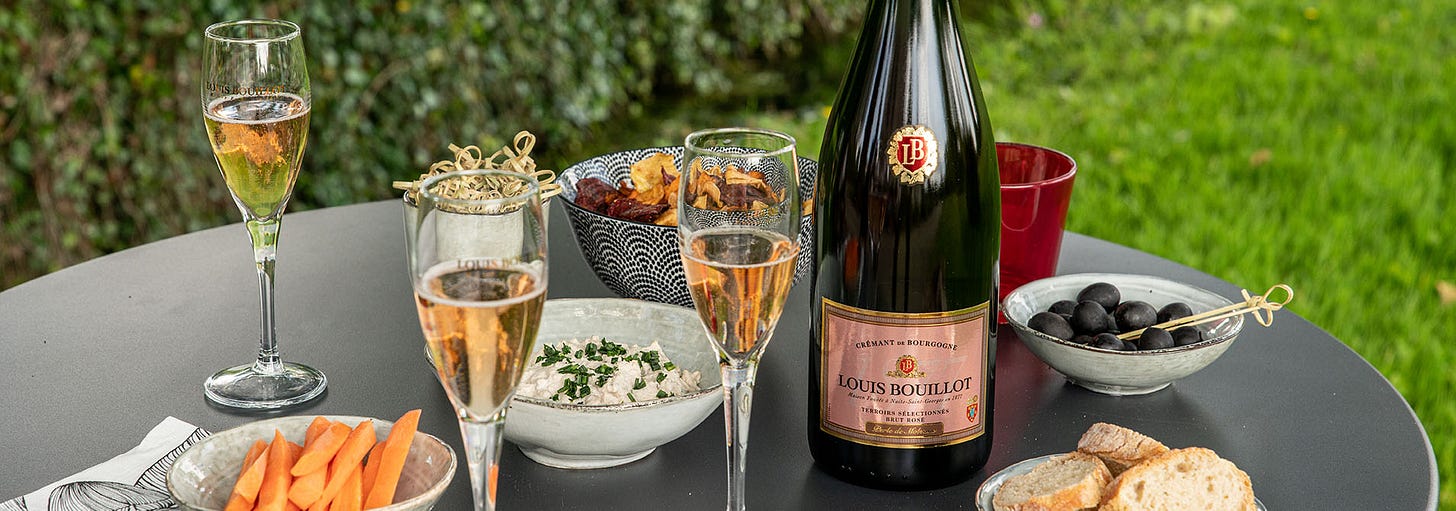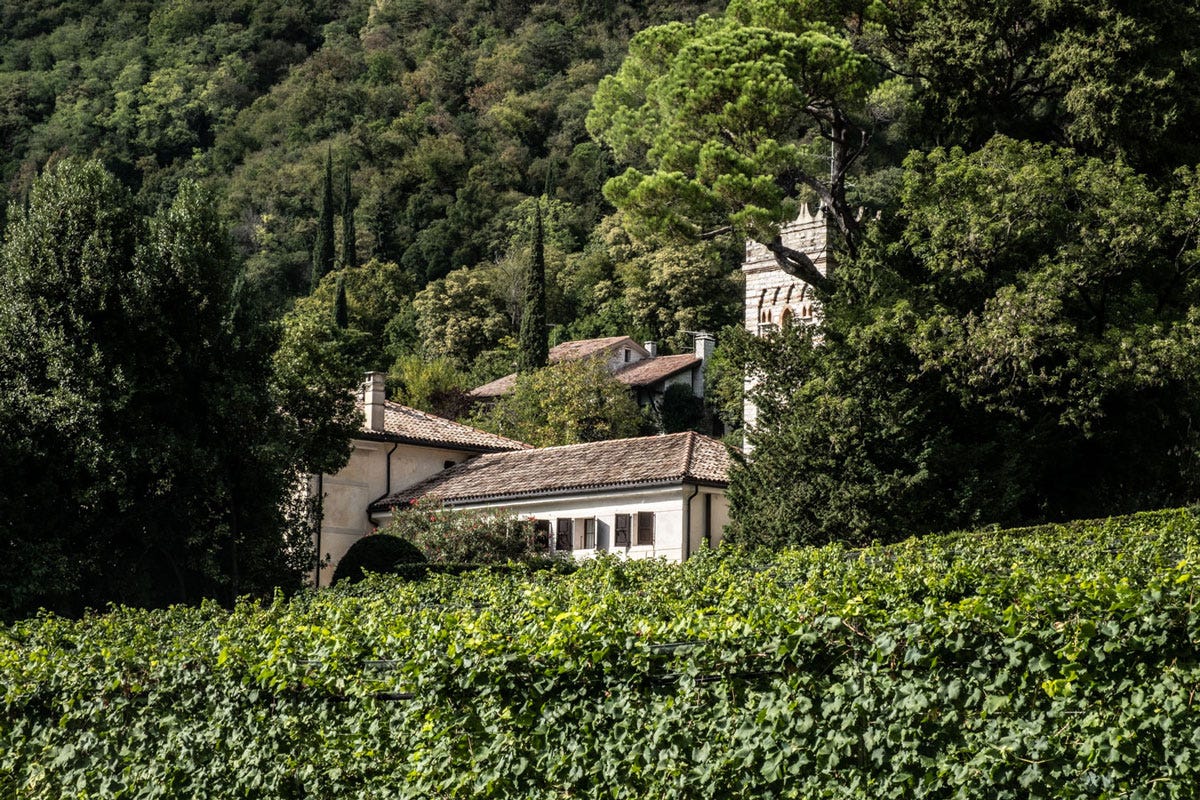Sparkling Wines That Deserve A Spot In Your Rotation
What do you think of when someone says “bubbles” or “sparkling”? (In wine terms, of course.)
I’ll go out on a limb and say most people immediately think of Champagne or Prosecco. Fair enough – those are the big names with the most recognition, especially here in the U.S. But there’s a whole sparkling world out there that doesn’t always get the love it deserves.
Since wrapping up my WSET Level 2 in wine, I’ve been on a bit of a sparkling wine journey driven by curiosity. There was only a small section on it in the course - mostly in regard to Champagne. BUT I’m convinced sparkling wine could (and probably does) have an entire course to itself. I need to do some additional research.
Anyways, I’ve let my curiosity lead the way, tried a bunch of new styles, and uncovered some new favorites I can’t wait to share with you.
Whether you’re looking to branch out or upgrade your usual go-to – here are a few for you! Cheers!

Sparkling Roll Call
(1st edition – because there’s a lot to unpack in this category)
Champagne (France)
Crémant (France)
Prosecco (Italy)
Lambrusco (Italy)
Cava (Spain)
Domestic Sparkling (U.S.)
Let’s break ‘em down:
Champagne
The queen bee of sparkling wines. True Champagne can only be labeled Champagne if it:
Comes from the Champagne region in France.
Is made using the traditional method (aka méthode champenoise).
This method involves a second fermentation in the bottle which gives Champagne its signature fine bubbles and complex flavors.
I’m actually reading ‘Champagne: How the World’s Most Glamorous Wine Triumphed Over War and Hard Times’ by Don and Petie Kladstrup right now. It’s full of fascinating stories about how Champagne survived and eventually thrived during World War I.
Dinner party facts:
Champagne is typically made from Chardonnay, Pinot Noir, and Pinot Meunier.
Non-Vintage (NV) Champagne is blended across years to keep a consistent house style. If you're familiar, it's similar to how Bourbon is blended with no age statement so it tastes the same every time.
Two to try:
Widely available but still feels special. Full-bodied and generous, with golden apple, pear, and a little brioche on the finish. Red label = instant pop. Also rumored to be Marilyn Monroe’s favorite.
Led by women for generations. More floral and delicate than Piper-Heidsieck, with a whisper of peach and toast. Mostly Chardonnay. Elevated but still under $75 - great for date night or a personal splurge.

Photo Source: Laurent-Perrier Crémant
Ever heard of it? I hadn’t until maybe five years ago. Now I see it all the time - even at Whole Foods. Crémant is definitely becoming more mainstream, and for good reason: it’s affordable, delicious, and you don’t have to sacrifice quality.
Crémant is also a French sparkling wine, made in the traditional method, but grown outside Champagne. You’ll find Crémants from Burgundy, Alsace, the Loire Valley, and beyond.
Taste profile: Crisp, elegant, with notes of green apple, brioche, and citrus zest. Basically, Champagne’s cooler (and cheaper) cousin.
Two I recommend:
Veuve Ambal Crémant de Bourgogne Brut
A solid Burgundy sparkler that over delivers. Orchard fruit, lemon zest, and a hint of toast. Easy to find. Great value.
Louis Bouillot ‘Perle d’Aurore’ Brut Rosé (Crémant de Bourgogne)
I love, love this one! Wild strawberry, raspberry, and rose petal. Super dry and elegant. Pretty in the glass, even better in your glass. Find it at Total Wine. I’ll definitely be sipping this during our Bordeaux trip this fall.

Photo Source: Louis Bouillot Prosecco
Italy’s sparkling sweetheart AND the backbone of a great Spritz (Hugo or Aperol for me, please.)
Prosecco hails from northeastern Italy (Veneto + Friuli) and is made using the tank method (aka Charmat), which makes it more affordable and fruit-forward. Bubbles are lighter and frothier compared to Champagne.
Like Champagne, Prosecco is also regionally protected and must be made from at least 85% Glera grapes.
Two I love:
You’ve definitely seen this at your local grocery store. Crisp, floral, and perfect for topping that spritz.
Nino Franco 'Rustico' Valdobbiadene Prosecco Superiore DOCG
Chef’s kiss. Must-order if you see it on a wine list. Elegant and delicate with a gorgeous floral bouquet. Picture-perfect aperitif wine.

Photo Source: Nino Franco Lambrusco
A sparkling red wine? Yes – it’s having a moment.
Lambrusco is from northern Italy (Emilia-Romagna) and usually comes in a frizzante style (lightly fizzy). Not to be confused with spumante, which is fully sparkling. Frizzante = Fizzy vs. Spumante = Sparkling. AKA Small bubbles vs. Big bubbles.
Dry or off-dry with dark berries, violet, and sometimes a savory edge – it’s..dare I say refreshing? and totally unexpected. Perfect with pizza, burgers, or a great charcuterie board.
I first tried Lambrusco at Quality Italian in Denver, CO and immediately went on a mission to track down a few bottles back home. It’s certainly not for every occasion, but it’s a fun one to try if you’re looking to mix things up. I’ve also seen people getting crafty and using it in cocktails – I must give that a try as well!
Two to try:
Alfredo Bertolani Lambrusco Reggiano All’Antica Rosa
Classic style. Juicy red fruits, a little earthy. They also make a great rosé version that tastes like fresh berries.
Cleto Chiarli Rosé de Noir Brut NV
Rosé Lambrusco! Vibrant, fresh, and berry-driven. A great intro bottle and a bit of a wild card crowd-pleaser for brunch or backyard hangs.
Cava
Spain’s answer to Champagne - and one of the best-value sparkling wines on the market.
Cava is made using the traditional method, like Champagne and Crémant, and mainly comes from the Penedès region in Catalonia. IMO - This has a very similar profile to Champagne and Crémant and is a GREAT alternative to French style sparkling wines.
Taste profile:Zesty citrus, green apple, almond, and sometimes brioche or toast (especially if aged longer).
Label decoding:
Cava = aged 9+ months.
Reserva = aged 15+ months.
Gran Reserva = aged 30+ months and must be Brut or drier.
Two I recommend:
I had this at Théa in Scottsdale, Arizona (Global Ambassador Hotel) and could’ve sworn it was Champagne. Mineral-driven, crisp apple and citrus. Made by a family that’s been doing this since the 1400s (hello!!).
Segura Viudas Cava Brut Reserva
A go-to value pic ~$10–$13. Fresh, festive, and lightly nutty from extended aging. Looks more expensive than it is. You can find it at Whole Foods.

Photo Source: Raventós Sparkling Wine from the U.S.A.
Don’t sleep on domestic bubbles (like I have for so long), especially from California and Oregon. While they can’t be called Champagne, many are made using the same traditional method with Pinot Noir and Chardonnay.
Taste profile:This one is tricky (and probably why I stayed away for so long). Taste is often crisp, apple-y, and floral with good acidity. Some can even rival entry-level Champagne.
Two to try:
Chandon Reserve Blanc de Blancs, By the Bay (Carneros, CA)
Fresh, coastal, and 100% Chardonnay. Zippy citrus, green apple, and a sea breeze finish. Sleek and super drinkable. Chandon is widely available — this one may be harder to find, but worth the hunt.
Roederer Estate Brut (Anderson Valley, CA)
California’s Champagne dupe. Dry, elegant, and made by the same family behind Cristal. If you’re skeptical about U.S. sparkling, start here.

Photo Source: Roederer Estate Last Sip
Sparkling wine isn’t just for New Year’s Eve anymore (and hasn’t been for a while). It’s one of the most versatile categories in wine. Whether you’re splurging on Champagne, sipping Crémant during the week, or bringing Lambrusco to your next BBQ, there’s a sparkler out there for every occasion.
Got a favorite sparkler I should try?
Cheers,
Meredith Z.


